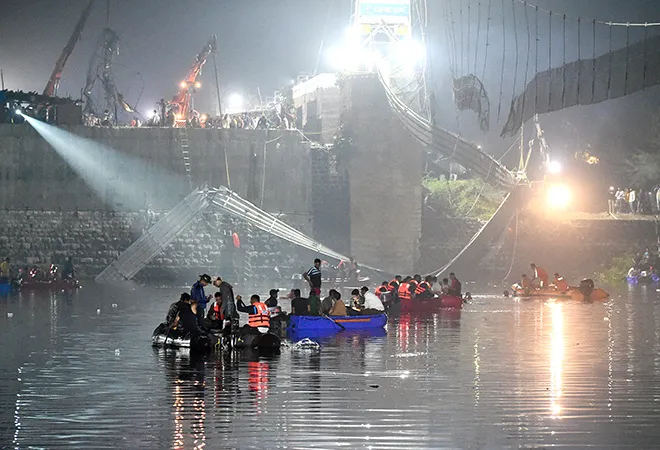-
CENTRES
Progammes & Centres
Location
A shortage of staff and funds and an outdated municipal governance system weigh the ULBs down, disabling them from properly executing their duties

In the background of impending state elections in Gujarat and other states, Morbi may have attracted greater notice than usual. The heightened attention was also a consequence of the recent tragedy that resulted in over 100 deaths, including a large number of children. However, public discussion and analysis have been concentrated on the possible irregularities in awarding the work, the flawed contracting processes and the arrest of cronies allowing the ‘real’ culprits to escape culpability. What appears to have missed the eye is that Morbi was not the first infrastructure failure in municipalities. They have been occurring on a regular basis across the country and in cities of all sizes.
Morbi, a town in Gujarat, located at a distance of 60 km from Rajkot, with a population of about 200,000 is situated on the Machhu river. Its suspension bridge, locally called ‘Jhulto Pul’, collapsed just four days after the bridge was reopened after repairs, killing 135 men, women, and children. The bridge was 230 metres in length and 1.25 metres wide, located 15 metres above the Machhu river. Built in the 1880s for royalty, it provided connectivity between the two palaces. The bridge is now owned by the local municipal body and is now operated as a toll bridge, maintained by the Oreva company since 2008. Following the collapse of the bridge and the tragedy, the Gujarat High Court, on 7 November 2022, filed a suo motu PIL and issued notice to the government, municipal authorities, and the state human rights commission and demanded a report. Now that the High Court is seized the matter, some of the real reasons for the tragic event are beginning to emerge.
In March 2016, part of a flyover in Kolkata that was still undergoing construction fell, killing more than 50 people and injuring 80 others.
The intention of this article is to point out that Morbi is not the first municipal bridge that has collapsed. It has been preceded by many others and it is likely that many may follow if the overall disinterest in the well-being of the cities and their fundamental weaknesses are not addressed. These lie in the areas of planning, governance and finance.
First, let us list some of the bridge tragedies and collapses that have occurred during the last decade. In March 2016, part of a flyover in Kolkata that was still undergoing construction fell, killing more than 50 people and injuring 80 others. In June 2016, a wooden bridge near the Island Grounds of Chennai gave way leading to about 30 women falling into the Cooum river. Luckily, they were rescued and they escaped with minor abrasions. In July 2018, an overbridge in Mumbai’s Andheri fell and killed two men. In September 2018, another flyover in Kolkata gave way. In March 2019, a foot overbridge in south Mumbai crashed killing six people and injuring 30 others. In April 2022, a section of under-construction bridge over the Ganga collapsed in Sultanganj, Bihar. In the same month, in Madhya Pradesh’s Narmadapuram, a British-era bridge collapsed while a trailer truck was crossing it. Several other examples could be listed; suffice it to say that many built bridges in India appear to be unsafe and many that are under construction have been found lacking in due precaution and care.
Bridges are very significant pieces of infrastructure in cities. Their primary objective is to enable citizens to traverse a terrain obstacle that otherwise could not have been possible. The most prominent obstacles are water bodies such as river, sea, or sewers. In some instances, bridges may serve to provide quick travel across an area of heavy traffic congestion or allow safe passage, such as for pedestrians who otherwise would have had to negotiate through dangerous and fast-moving automobiles. It is more than evident that such bridges are critical for city transportation and city economy.
Bridges may serve to provide quick travel across an area of heavy traffic congestion or allow safe passage, such as for pedestrians who otherwise would have had to negotiate through dangerous and fast-moving automobiles.
An additional factor that has to be borne in mind in India is that a very large number of cities have huge traffic and human movement across such structures. At times, bridges have end-to-end traffic on them for hours. Additionally, many of the transport vehicles (trucks and multi-axle vehicles) crossing these bridges are frequently overloaded. Court rulings in regard to overloading and the penal action that ought to follow for erring vehicles are well laid out. However, their implementation leaves much to be desired and one would have to concede that overloading is taking place in large measure. This has implications for bridges in terms of their ability to take the load. It is extremely important that while specifying bridge strengths for construction, these factors need to be always taken into account.
Building bridge infrastructure is merely one part of the job. Bridges, like all other infrastructure, have to be maintained. While most municipal bodies in India have a department of roads, bridges generally happen to be clubbed with that department. One need not stress the fact that while road maintenance is important, bridge maintenance is doubly so. Bad roads impede transportation and a city’s economy; but a bridge collapse puts a complete break on transportation for a prolonged period and snuffs out lives. However, proper maintenance can prolong the useful life of bridges and prevent deterioration that leads to more extensive and costly repairs.
The fact that so many bridges have collapsed in different cities one after the other seems to point out that bridge infrastructure failure is a widespread phenomenon. An examination of the matter reveals that there could be several causes behind these occurrences. In rapidly expanding cities, there is a constant demand for more infrastructure. The rapid increase in automobiles results in greater traffic congestion mandating more bridges. At the same time, there is a larger backlog of maintenance, because every new piece of infrastructure is an additional piece to maintain. Urban local bodies do not appear to be able to deal with both, and in general, fresh infrastructure gets prioritised and maintenance requirements get relegated. Here again the reasons are several—lack of maintenance systems, lack of resources, lack of manpower and lack of internal capacity—all linked to ULB planning, governance and finance.
Urban local bodies do not appear to be able to deal with both, and in general, fresh infrastructure gets prioritised and maintenance requirements get relegated.
The Brihanmumbai Municipal Corporation (BMC) is one of the few ULBs that has a Bridge Manual. It prescribes that each bridge should be inspected twice a year (April and October). This was not being meticulously followed till bridges actually fell. Post bridge collapses in Mumbai, the BMC undertook a bridge audit of the city’s bridges in phases. The audit declared a total of 29 bridges that were dangerous and advised they be demolished. BMC has, accordingly demolished eight of them and the others have been shut down. While this has created added traffic congestion on certain roads, the administration cannot take the risk of leaving these bridges operational for fear of sudden failures. Most cities would lack a manual and a well laid out annual maintenance programme for bridges.
The lack of a bridge maintenance system gets compounded by the lack of staff as well as their competence for inspection and maintenance jobs. In case in-house engineers cannot undertake the job, outside consultants could be hired. However, most cities would not have the money to employ quality consultants. With inadequate finances, a shortage of quality staff and an outdated municipal governance system that is slow and cumbersome, ULBs find it difficult to face the onslaught of rising infrastructure demand and maintenance in their cities. While in many cases, malfeasance and irregularities may be present, the widespread nature of the problem needs to be seen in the light of fundamental deficits that are not getting fixed. Sadly, redressal does not lie with the cities as the levers of substantive control lie in the hands of the states.
The views expressed above belong to the author(s). ORF research and analyses now available on Telegram! Click here to access our curated content — blogs, longforms and interviews.

Dr. Ramanath Jha is Distinguished Fellow at Observer Research Foundation, Mumbai. He works on urbanisation — urban sustainability, urban governance and urban planning. Dr. Jha belongs ...
Read More +